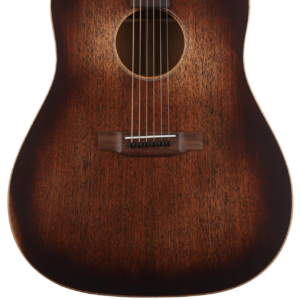Martin’s DSS-15M with Sloped Shoulders and StreetMaster Styling
Mahogany mystique hits the streets as an affordable slope-shoulder dreadnought
Specs include: Slope-Shoulder Dreadnought size; solid mahogany back, sides, and top; satin finish with StreetMaster® distressed toner; solid mahogany neck with Modified Low Oval Profile; solid katalox fretboard with 1-11/16″ width at the bone nut; solid katalox belly bridge with compensated drop-in bone saddle, 2-1/8″ string spacing; scalloped A-Frame X bracing; Simple Dovetail neck joint; Old Style gold headstock logo; Golden Age relic tuners with cream buttons; short pattern Diamonds and Squares fretboard markers
“…as the thicker mids and barrel-chested bass notes are humming away, the trebles ring with a musicality that just puts a smile on my face, and effortless in how they are heard clearly from atop that warm, woody undertone, until their own sustain dips down into the massive cellar to meld with the lower registers. “
Masterful Mahogany
The Martin DSS-15M StreetMaster is a Dreadnought size acoustic guitar with the Slope-Shoulder body shape, made in Style 15, which has solid mahogany for the back and sides and top, and Martin’s special distressed satin finish unique to the StreetMaster models.
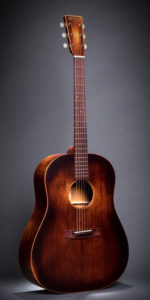 The DSS-15M StreetMaster has a modern, 14-fret neck attached to a large body with a shape similar to Martin’s original 12-fret dreadnoughts invented in 1916. This revised dreadnought shape gives the guitar an impressive voice that offers a nice alternative to the customary D-15M square-shoulder dreadnought.
The DSS-15M StreetMaster has a modern, 14-fret neck attached to a large body with a shape similar to Martin’s original 12-fret dreadnoughts invented in 1916. This revised dreadnought shape gives the guitar an impressive voice that offers a nice alternative to the customary D-15M square-shoulder dreadnought.
The mahogany top sound isn’t complex or full of layered harmonics. It is simple and simply lovely. Plump, warm, and mellow. There is a fullness to the interior of the voice during fingerpicking or drawn-out strums that is as inviting as a feather bead for a bowl of chocolate pudding straight off the stove. And the flavor of each bass note lasts a long time as it hangs in the air.
That basic but strong sustain is one reason Blues-oriented slide players like mahogany tops. And in general the large sound chamber on the DSS-15M StreetMaster gives off a bigger, fuller voice than other 15s, with satisfying sustain.
But even as the thicker mids and barrel-chested bass notes are humming away, the trebles ring with a musicality that just puts a smile on my face, and effortless in how they are heard clearly from atop that warm, woody undertone, until their own sustain dips down into the massive cellar to meld with the lower registers. It a brothy voice of substance and delicious roundness that is quite different than what’s from a mahogany guitar with a spruce top.
Along with the new spruce-topped DSS-17 models, this is the first appearance of the 14-fret slope-shoulder dreadnought design as a regular Martin model. All previous DSS size Martins were limited editions. Martin’s first slope-shoulder dreadnought was the CEO-4, from 2002. But they didn’t officially use the DSS designation until the DSS-2018 appeared as the Winter NAMM Show Special last year. And what a wonderful introduction to the main line of the Martin catalog is this gorgeous DSS-15M StreetMaster!
Masterful Mahogany
No DSS model has looked remotely like a StreetMaster Martin, with its mahogany top under a visually distressed satin finish that was designed to look at first-glance like the sort of well-worn old guitar one might see in the hands of a veteran street musician, or “busker” as they are often called. But on closer inspection, the visual special effects are achieved though manipulating the hue of the toner in a carefully thought out manner, which is much more artistic in its looks than simply scraping off some the finish
I have always been drawn to the Style 15 guitars, with their deep, dark brown pigment similar to the vintage Style 17 instruments from the 1930s. But with the modern-day satin finish that shows so much grain detail, it often reminds me of a freshly ground coffee, or the shell of a Brazil nut. But the Style 15 look is very much a one note sort of thing, in terms of the color.
The StreetMaster effect takes that deep uniform brown and lightens up various areas, which sort of look like patches that have been worn down through long use. And they also darken other areas beyond the standard nut brown of the basic 15 Series instruments, so that some outer edges look blackened to pitch.
But when I stop and take a good look at a StreetMaster model, it seems more like the instrument is being illuminated by small, well-placed spot lights. In fact they refer to the shading effect on the top as the Mahogany Burst, which is a subtler sort of sunburst than used on other models, and varies slightly on each individual instrument. And the StreetMaster version of this special burst top has a more interesting effect, with a radiant center trained on the sound hole, which sends some rays of lighter hue across the top to the darker edges. It reminds me of the corona around a solar eclipse.
The sides, back, and neck do not have the same sort of central focus to the contrasting shades, but still get varying patches of lighter and darker hues, again as if a dark surface was hit by various light sources. It is visually dynamic in its effect and quite attractive. And the back and sides tend to be lighter over all, showing off the mahogany grain a bit better than the top.
But even cooler, this change of brightness and contrast worked into the guitar’s finish looks particularly dynamic on stage, under lighting of various colors. I have seen a variety of StreetMaster instruments on stage in New York City, and when hit with reds or blues or green pigments, the lighter “worn away” patches take on their own hue and stand out from the darkest sections for a very impressive 3D visual effect.
From the few DSS-15M StreetMaster examples I have seen thus far, it seems the toner effects have darker highlights and shading than the other StreetMaster models, which have streaks and patches that are lightened to the point of being nearly blonde, and which do look more like worn away finish from a distance.
I do not yet know if this subtler, darker overall distressing will prove unique to the new slope-shoulder dreadnought model, or if we will start seeing a trend across the whole StreetMaster line. But I do like it very much.
The fretboard and bridge are made from solid katalox, a tropical American hardwood often called Mexican ebony, because of its high density and the fact the heartwood can be quite black. But the katalox Martin choses for this purpose has a lighter, dusty milk chocolate appearance that looks a great deal like the rosewood used for boards and bridges on Style 15 guitars from previous eras, and adds another kind woodiness to the overall aesthetic.
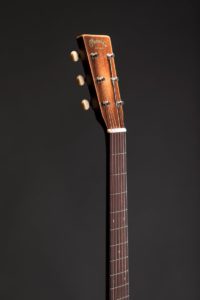 |
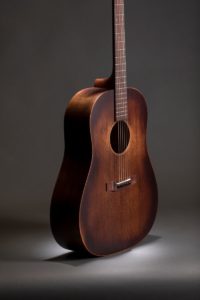 |
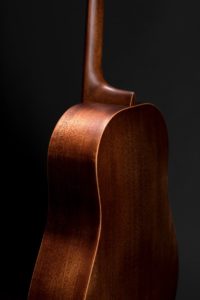 |
Simple and Sound
Martin came up with the Style 15 concept during the Great Depression, to offer a solid wood Martin for the lowest possible price. The first and only Style 15 Martin made with a mahogany top was the 0-15, first released in 1940 and made sporadically thereafter until the early 1960s. It had no binding, a simple rosette, and three small dots on the rosewood fretboard. Woody Guthrie called it the People’s Martin because it was their most affordable guitar.
And that same idea applies the 15 Series guitars of today, through the use of simple but tasteful visual appointments, a simplified bracing pattern that works exceptionally well for the dense mahogany soundboard, and the Simple Dovetail Neck Joint, which is a major improvement over the Mortise and Tenon Neck Joint that was used on the 15 Series until recently. All of them help keep the price low while still offering a Martin made entirely of solid tonewoods.
The new DSS-15M StreetMaster gets the same vintage-esque appointments of other guitars in the modern 15 Series, which includes the fancier short pattern Diamonds and Squares fret markers that was actually used on Style 28 instruments back in the day. But they do give an old-timey appearance that is extended to the entire instrument by the simple black and white ply rosette, Old Style Script headstock logo, and Golden Age relic tuners with cream buttons, which look quite similar to what was used on a 1940s 0-15.
And while there is no body binding or purfling around the edge of the top, which just makes it all look the woodier, the StreetMaster distressing technique lightens the edge of the sides, which actually suggests the appearance of wooden binding, without adding the cost of actual binding.
The simple bracing pattern used for this model was an accidental blessing when it appeared on the first modern-era 15s. It has fewer tone bars supporting the main X brace, and was originally a cost-cutting move for the 1 Series, Martin’s first attempt at offering entry level instruments under their own brand, in the late twentieth century. And while it does not provide the best sound possible when used under a spruce top, it works very well indeed with a mahogany top, because it is made from hardwood and is therefore not as flexible or responsive as spruce.
When Martin has made guitars with hardwood tops supported by their full, traditional bracing, they have often sounded rather muffled, because the hardwood takes many years to play-in and open up. But the 15s sound delightful, with a pretty musicality right out of the box. They do have a thicker, warmer sound down inside the voice, compared to similar guitars made with a spruce top, but that is a part of the charm. The fundamental notes do not stand out from the body resonance as much, but rather are more integrated with it, although the unwound treble strings project clearly and to a greater extent than do the wound strings.
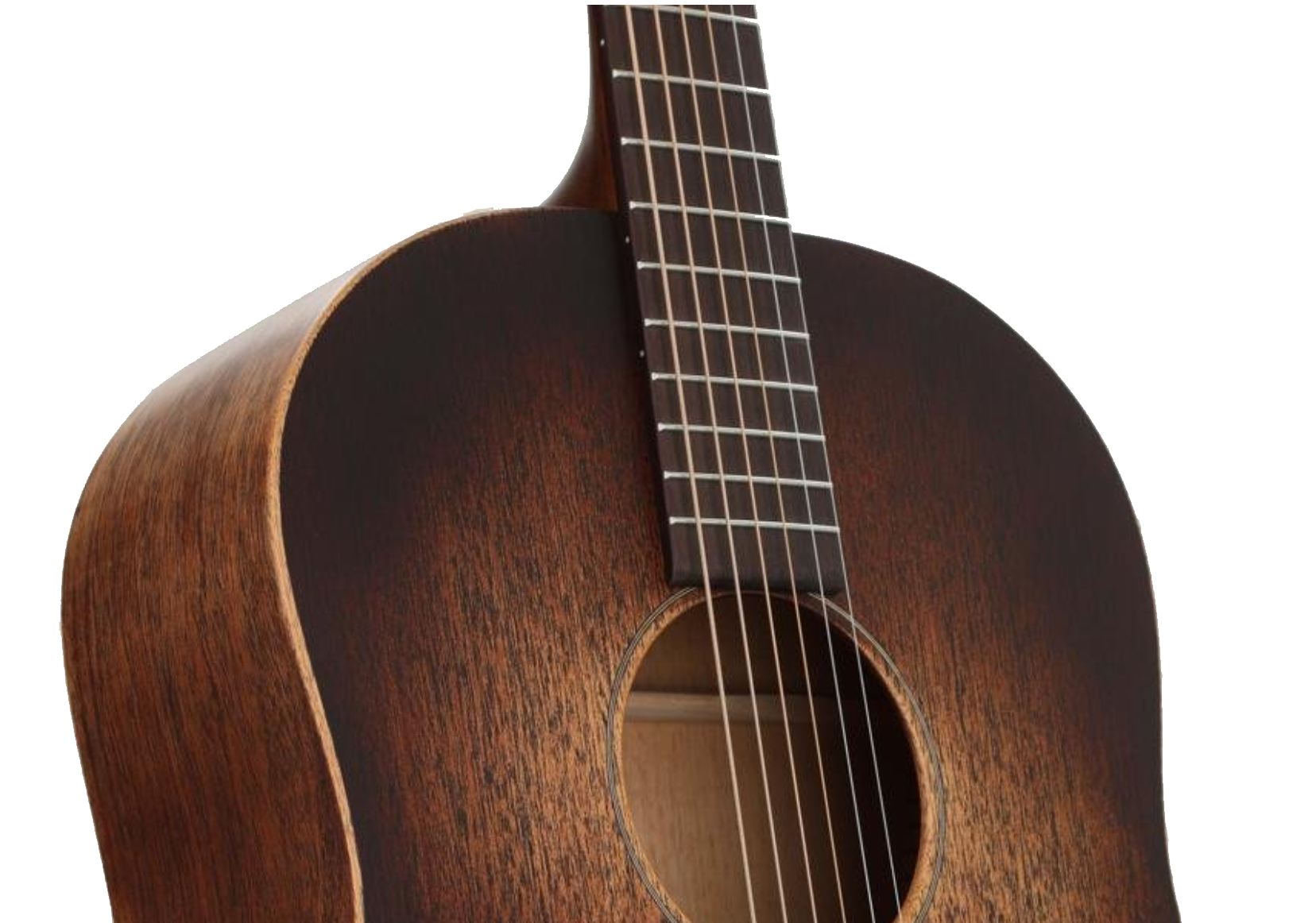 It is unique, this 15 Series tone, and can add new sonic flavors to a guitar collection of spruce-topped instruments. And some people prefer the mahogany top sound first and foremost, especially when they have owned such a guitar for the two years or so required for it to really open up, so that the voice mellows even more, and grows sweeter and prettier. And now 15 Series fans have one more body size to fall in love with, which has its own particular tonal palette and personality, thanks to the large slope-shoulder shape.
It is unique, this 15 Series tone, and can add new sonic flavors to a guitar collection of spruce-topped instruments. And some people prefer the mahogany top sound first and foremost, especially when they have owned such a guitar for the two years or so required for it to really open up, so that the voice mellows even more, and grows sweeter and prettier. And now 15 Series fans have one more body size to fall in love with, which has its own particular tonal palette and personality, thanks to the large slope-shoulder shape.
Another simple but important feature that contributes to the special tone of the DSS-15M StreetMaster is its Simple Dovetail Neck Joint. It has replaced the Mortise and Tenon Neck Joint that preceded it on most models offered in styles below Style 18. Not only does it provide a much more stable anchorage for the neck where it connects to the body, it allows much more energy exchange between the two body parts. It does not provide as much transference and resulting resonance as the full-size hand fitted dovetail neck joint used on higher-end Martins. But that is not necessarily a bad thing where a mahogany top is concerned, because I believe it helps keep the voice from becoming too overly thick and woofy.
In any case, the DSS-15M StreetMaster sounds very good in its own right, and I will not be surprised if it quickly starts to outsell the square-shoulder D-15M as a result.
While the slope-shoulder dreadnought shape may give the appearance of being larger than the square-shoulder dreadnought, this may not actually be the case. (I am still waiting for my insider sources to pass on the mechanical drawings.) The best way I can describe the difference is to say it looks like the sides of the two dreadnought designs may in fact be of the same length. But they rounded the DSS shoulders by curving them sooner as the sides expand from the neck, so more wood is available father along the sides, which allows for increased width of the bottom bout. Therefore, the actual area of the top and back may add up to the same square inches or centimeters, and the cubic volume inside the sound chamber may add up to the same amount, but the architecture has changed. And that is enough to change the tonal balance and dynamics.
The move to start using this DSS shape came from C.F. Martin IV’s liking the looks of the Gibson Jumbo guitars from the Great Depression era, particularly the J-45. And he decided to design his version for his CEO Series, which led to other editions in the same series with the same body shape. None of his CEO designs sound like a J-45, of course. It would take a lot more than the body shape to make a Martin sound much like a Gibson, just like how none of the Gibson square-shoulder dreadnought models they made for decades sound not at all like the Martins that inspired them. In both directions, the results were truly new designs that have their own unique sound.
This kind of experimentation can’t be anything but a good thing. I mean, look at the millions of acoustic guitars that were based on original Martin designs that evolved with their own tonal properties, and have filled the world with unique music.
In recent years the modern day Martin Company brought their know-how into creating new models made with body sizes and shapes that originated elsewhere, but infused with Martin personality to create entirely new sounds. And the latest is a slope-shoulder dreadnought, with a mahogany top that looks and sounds a long way’s different from any J-45! And as it makes its way into shops around the world, I expect it will be the sound, with its satisfying bass rumbling out of its big body, which will win even more fans than the cool StreetMaster special visual effects of this newest Martin model.
The Skinny on the Neck and the Moniker of Mahogany
The 15 Series instruments started out as some of the first Martins to use the Modified Low Oval Profile, which is now their standard neck shape. And it has gone on to become the last series in the catalog to retain the 1-11/16” neck width-at-nut, at least on certain models. And that includes the DSS-15M StreetMaster.
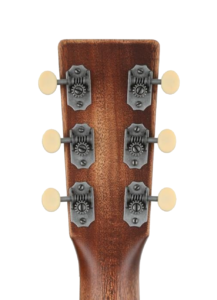 In January, 2018 Martin converted their Standard Series instruments to the High Performance fretboard taper, which has a now-industry-standard 1-3/4” width at nut, while remaining narrower in the upper frets than their traditional 1-3/4” of previous eras. And they have since converted almost all of their non-vintage reissue models to this taper. The reason the 000-15M and D-15M have not changed to the wider nut is simple; they sell very well just as they are, with the (slightly) skinnier neck. And the new slope-shoulder model was given the same neck as its square-shoulder counterpart.
In January, 2018 Martin converted their Standard Series instruments to the High Performance fretboard taper, which has a now-industry-standard 1-3/4” width at nut, while remaining narrower in the upper frets than their traditional 1-3/4” of previous eras. And they have since converted almost all of their non-vintage reissue models to this taper. The reason the 000-15M and D-15M have not changed to the wider nut is simple; they sell very well just as they are, with the (slightly) skinnier neck. And the new slope-shoulder model was given the same neck as its square-shoulder counterpart.
I have said for years that the 15 Series Martins offer an incredible bargain for money. And this new StreetMaster slope-shoulder dreadnought qualifies for that claim big time. Some people do not like the fact they are made with African species from the mahogany family (either sapele or sipo and possibly both at the same time, based on availability.) Unfortunately the Big Leaf mahogany from South America is basically an endangered species in the wild, and plantation-sourced wood is a lot more expensive than the African alternative. Martin now always refers to Big Leaf mahogany from the tropical Americas as “Genuine mahogany” and it is reserved for the more expensive Martins of the Standard Series, Authentic Series, and their new Modern Deluxe Series.
African mahogany species are referred to as simply “mahogany.” And while certain people do not consider such woods actual mahogany, the fact is botanists get to decide what species qualify for the mahogany family, not guitarists. And while a guitar made with African mahogany species for its back, sides, top, and neck may not sound exactly like an identical guitar made with South American mahogany, the two instruments would sound much more alike than they would sound like guitars made from anything else. And most people would probably not notice any difference.
The Company had the choice of either discontinuing the 15 Series altogether or converting the guitars to the African varieties. And given how incredibly well they sell and are enjoyed by their owners, it seems they made the right choice. Frankly, whatever differences there may be in tone between tropical American mahogany and tropical African mahogany, it tends to be heard in bottom end presence, and matters less and less the larger the body sizes go. And this DSS body size puts out loads of bottom end with plenty of undertone presence supporting the sweet, musical trebles.
My favorite 15 Series instruments to date have been the 12-fret D-15MS and 000-15MS. But I usually need more than 14 frets as it is, so I have never considered purchasing one for myself. The DSS-15M StreetMaster offers some of that hefty 12-fret sound, without putting the top-most frets out of reach. And it is nicely appointed, with the varying toner contrast that livens up the rich brown Style 15 finish. And all for a price that is well within reach for anyone even considering buying a Martin guitar.
That is why I expect to see these masterfully manipulated mahogany Martins appearing on the streets of New York more and more.
That is one man’s word on…
Martin DSS-15M StreetMaster
List Price: $17,999.00 – Ask your Martin dealer for their best price!
More Photos Here
Related Reading:
DSS-17 Whiskey Sunset \ Black Smoke Review
D-18 Modern Deluxe Review
D-28 Modern Deluxe Review
Martin CEO-9 Review (coming soon)
